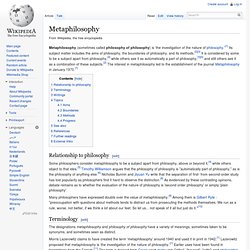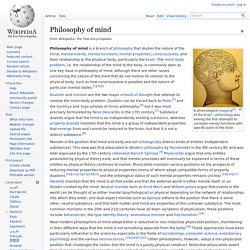

Skepticism. People. Logic. Metaphilosophy. Relationship to philosophy[edit] Some philosophers consider metaphilosophy to be a subject apart from philosophy, above or beyond it,[4] while others object to that idea.[5] Timothy Williamson argues that the philosophy of philosophy is "automatically part of philosophy," as is the philosophy of anything else.[6] Nicholas Bunnin and Jiyuan Yu write that the separation of first- from second-order study has lost popularity as philosophers find it hard to observe the distinction.[8] As evidenced by these contrasting opinions, debate remains as to whether the evaluation of the nature of philosophy is 'second order philosophy' or simply 'plain philosophy'.

Many philosophers have expressed doubts over the value of metaphilosophy.[9] Among them is Gilbert Ryle : "preoccupation with questions about methods tends to distract us from prosecuting the methods themselves. We run as a rule, worse, not better, if we think a lot about our feet. So let us... not speak of it all but just do it. C.
Philosophy of mind. A phrenological mapping[1] of the brain – phrenology was among the first attempts to correlate mental functions with specific parts of the brain Philosophy of mind is a branch of philosophy that studies the nature of the mind, mental events, mental functions, mental properties, consciousness, and their relationship to the physical body, particularly the brain.

The mind–body problem, i.e. the relationship of the mind to the body, is commonly seen as one key issue in philosophy of mind, although there are other issues concerning the nature of the mind that do not involve its relation to the physical body, such as how consciousness is possible and the nature of particular mental states.[2][3][4] Mind–body problem[edit] Our perceptual experiences depend on stimuli that arrive at our various sensory organs from the external world, and these stimuli cause changes in our mental states, ultimately causing us to feel a sensation, which may be pleasant or unpleasant. Arguments for dualism[edit]
The Missing Shade of Blue. The Missing Shade of Blue is an example introduced by the Scottish philosopher David Hume to show that it is at least conceivable that the mind can generate an idea without first being exposed to the relevant sensory experience.

It is regarded as a problem by philosophers because it appears to stand in direct contradiction to what Hume had just written. The source of the problem[edit] In both A Treatise of Human Nature and An Enquiry Concerning Human Understanding, philosopher David Hume argues that all perceptions of the mind can be classed as either 'Impressions' or 'Ideas'. He further argues that: "We shall always find, that every idea which we examine is copied from a similar impression. The problem of the missing shade of blue arises because just two paragraphs later Hume seems to provide just such an idea.
Dream argument. The dream argument is the postulation that the act of dreaming provides preliminary evidence that the senses we trust to distinguish reality from illusion should not be fully trusted, and therefore any state that is dependent on our senses should at the very least be carefully examined and rigorously tested to determine whether it is in fact reality.

Synopsis[edit] In Eastern philosophy and especially Chinese philosophy, this type of argument is well known as "Zhuangzi dreamed he was a butterfly" (莊周夢蝶 Zhuāngzhōu mèng dié): One night, Zhuangzi (369 BC) dreamed that he was a carefree butterfly, flying happily. After he woke up, he wondered how he could determine whether he was Zhuangzi who had just finished dreaming he was a butterfly, or a butterfly who had just started dreaming he was Zhuangzi. This was a metaphor for what he referred to as a "great dream": He who dreams of drinking wine may weep when morning comes; he who dreams of weeping may in the morning go off to hunt.
Notes[edit] List of unsolved problems in philosophy. This is a list of some of the major unsolved problems in philosophy.

Clearly, unsolved philosophical problems exist in the lay sense (e.g. Aesthetic relativism. Aesthetic relativism is the philosophical view that the judgement of beauty is relative to different individuals and/or cultures and that there are no universal criteria of beauty.

For example, in historical terms, the female form as depicted in the Venus of Willendorf and the women in the paintings of Rubens would today be regarded as over-weight, while the slim models on the covers of contemporary fashion magazines would no doubt be regarded in a negative light by our predecessors. In contemporary (cross-cultural) terms, body modification among "primitive" peoples is sometimes regarded as grotesque by Western society.
Aesthetic relativism might be regarded as a sub-set of an overall philosophical relativism, which denies any absolute standards of truth or morality as well as of aesthetic judgement. (A frequently-cited source for philosophical relativism in postmodern theory is a fragment by Nietzsche, entitled "On Truth and Lie in an Extra-Moral Sense. ") Tetrapharmakos. The Tetrapharmakos (τετραφάρμακος) "four-part remedy" is a summary of the first four of the Κύριαι Δόξαι (Kuriai Doxai, the forty Epicurean Principal Doctrines given by Diogenes Laërtius in his Life of Epicurus) in Epicureanism, a recipe for leading the happiest possible life.

They are recommendations to avoid anxiety or existential dread.[1] The four-part cure[edit] As expressed by Philodemos, and preserved in a Herculaneum Papyrus (1005, 4.9–14), the tetrapharmakos reads:[4] This is a summary of the first four of the forty Epicurean Principal Doctrines (Sovran Maxims) given by Diogenes Laërtius, which in the translation by Robert Drew Hicks (1925) read as follows: 1. 2. 3. 4. Don't fear god[edit] In Hellenistic religion, the gods were conceived as hypothetical beings in a perpetual state of bliss, indestructible entities that are completely invulnerable. Don't worry about death[edit] The Myth of Sisyphus. The Myth of Sisyphus is a philosophical essay by Albert Camus.

It comprises about 119 pages and was published originally in 1942 in French as Le Mythe de Sisyphe; the English translation by Justin O'Brien followed in 1955. In the essay, Camus introduces his philosophy of the absurd: man's futile search for meaning, unity, and clarity in the face of an unintelligible world devoid of God and eternal truths or values. Does the realization of the absurd require suicide? Camus answers: "No. It requires revolt. " Summary[edit] The essay is dedicated to Pascal Pia and is organized in four chapters and one appendix. Chapter 1: An Absurd Reasoning[edit] Cognitive closure (philosophy) It cannot be simply taken for granted that the human reasoning faculty is naturally suited for answering philosophical questions: the questions and their subject matter are one thing; and rational faculty, as a human trait, is another.

From the fact that it is the best faculty we have… for doing philosophy it does not follow that it is a remotely good or adequate faculty for that purpose.[3]—Colin McGinn, Problems in Philosophy: The Limits of Inquiry When human minds interact with philosophical problems, especially those of the form 'How is X possible?
', they are apt to go into one of four possible states. Either (i) they try to domesticate the object of puzzlement by providing a reductive or explanatory theory of it; or (ii) they declare it irreducible and hence not open to any levelling account; or (iii) they succumb to a magical story or image of what seems so puzzling; or (iv) they simply eliminate the source of trouble for fear of ontological embarrassment... Jump up ^ Errol E. Aesthetics. "Aesthetician" redirects here.

For a cosmetologist who specializes in the study of skin care, see Esthetician. More specific aesthetic theory, often with practical implications, relating to a particular branch of the arts is divided into areas of aesthetics such as art theory, literary theory, film theory and music theory. Formalism (philosophy) The term formalism describes an emphasis on form over content or meaning in the arts, literature, or philosophy. A practitioner of formalism is called a formalist. A formalist, with respect to some discipline, holds that there is no transcendent meaning to that discipline other than the literal content created by a practitioner. For example, formalists within mathematics claim that mathematics is no more than the symbols written down by the mathematician, which is based on logic and a few elementary rules alone. This is as opposed to non-formalists, within that field, who hold that there are some things inherently true, and are not, necessarily, dependent on the symbols within mathematics so much as a greater truth.
Formalists within a discipline are completely concerned with "the rules of the game," as there is no other external truth that can be achieved beyond those given rules. Sublime (philosophy) In aesthetics, the sublime (from the Latin sublīmis) is the quality of greatness, whether physical, moral, intellectual, metaphysical, aesthetic, spiritual or artistic. The term especially refers to a greatness beyond all possibility of calculation, measurement or imitation. Grosser Mythen, Swiss Alps. British writers, taking the Grand Tour in the 17th and 18th centuries, first used the sublime to describe objects of nature.